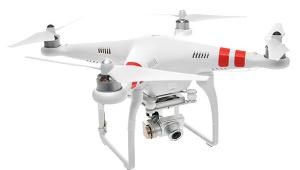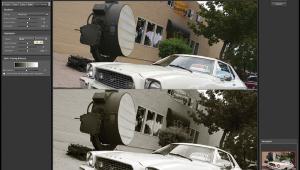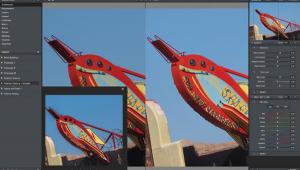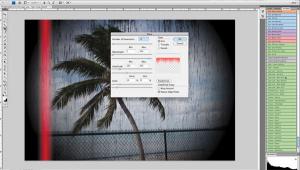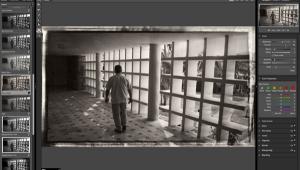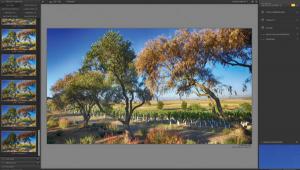Digital Innovations
Imaging With Mac OS X
Live From San Francisco Its A Mac World Expo 2002
"The new electronic interdependence recreates the world in the image of a global village."--Marshall McLuhan Home to a diverse, inquisitive people who openly embrace the "differently"-ness of Macintosh computers, San Francisco is the perfect place for MacWorld Expo 2002. I'll leave the Zen-like question of whether the trade show was half-empty or half-full of exhibitors for the pundits to decide, but the space in Moscone Center that was occupied was packed with enthusiastic crowds of Macophiles. The big hardware news was Apple Computer's launch of an all-new iMac with 15" LCD screen and 700MHz (an 800MHz chip is optional) G4 processor. Steve Jobs also announced a new and improved iBook laptop with a 14" screen. The original 12.1" screen model is still available with a lower price tag. As we went to press, Apple Computer announced speed bumps for its G4 computers, including a dual 1GHz model. More information about Apple's new computers can be found at www.apple.com. Image Software For OS X |
|
After being neglected for years, Equilibrium (www.equilibrium.com) produced an all-new DeBabelizer Pro 5 for Mac OS X--or as chairman Jobs calls the latest update "OS Ten dot One"--as well as offering a version for Microsoft Windows XP. DeBabelizer Pro 5 is bristling with new features that let you acquire images from different sources, edit and optimize, and then convert the resulting file into one of more than 100 image, information, or digital video formats for multiple platforms. DeBabelizer also lets you publish web catalog press pages complete with HTML, thumbnails, and JPEG files. This is must-have software for cross-platform imagers. If you're looking for a free image-editing program designed specifically for Mac OS X, download PixelNhance from www.caffeinesoft.com. This program has a deceptively simple interface that lets you compare original and current settings in real time using a split-screen window. Image options include brightness and contrast levels, color saturation, tone, sharpness, and noise reduction. You can also drag and drop settings as an OS X Action into Caffeine's (not free) TIFFany3, whose straightforward interface belies its powerful capabilities to process Actions in the program's "catalog." You can also mix and match an unlimited number of photographs in layers, each having different file type, size, resolution, or color space. TIFFany3 represents the first fresh take on imaging software since the late lamented Live Picture, but without that program's dense interface. You can download a demo of TIFFany3 along with the free Curator photo browser program from Caffeine's web site. Designed for Mac OS X, Apple Computer's iPhoto is a free download from www.apple.com/iphoto. This entry-level image-editing program lets you import, edit, save, organize, print, and share digital photographs while maximizing OS X's look and feel to make working with images as easy as Apple's iTunes plays music files. You can use the program to order professionally processed prints and enlargements up to 20x30", but iPhoto's most interesting feature may be its page layout capabilities. You can choose from one of six built-in book designs and iPhoto will automatically produce a book with one, two, three, or four photographs (with captions) per page that can be ordered online. For $29.99 you get back a linen-covered hardbound book with 10 pages. Additional pages are only $3 each. Version 2.0 of Synthetik Software's innovative Studio Artist image processing software (www.synthetic.com) is optimized for OS 8 and 9 as well as OS X v10.1 and includes QuickTime video tutorials and instructional guides. The program is built around a new image processing engine and has a user-configurable image processing toolkit. Studio Artist 2.0 includes many new image effects including Cartoon Simplify, Adaptive Filtering, and Gradient Modulation, new color transformational mapping, white balance, and matte keying for still and video applications. Other image enhancement products to watch out for are PhotoRetouch Pro by Binuscan (www.binuscan.com) that includes such interestingly named tools as "Baby Skin." Its dust removal tool called Vacuum is the best I ever seen. Asiva Photo (www.asiva.com) is not an image-editing program in the traditional sense; it uses vector-based enhancement technology to manipulate colors and lighting effects, sharpen or soften details, or change the overall impression from eye-popping to washed-out color. Asiva Photo has been optimized for the Power PC G4 processor and is available for Mac OS 8.6 or OS X. One booth constantly jammed during the show was e-on Software (www.e-onsoftware.com), whose Vue d'Esprit 4 had 'em standing in the aisles. I never got a chance to see the program until they sent me a review copy after the show. Vue d'Esprit 4 lets you create and render natural scenery in Bryce-like fashion. The interface is different and has a steeper learning curve than Photoshop Elements, but this OS X native program comes with two CDs full of models and presets that will get you started creating your own 3D worlds in a hurry. Plug-Ins On Parade Alien Skin Software (www.alienskin.com), those creative and wacky dudes and dudettes from Raleigh, North Carolina, added Splat! to their library of useful Photoshop compatible plug-ins that includes the wonderfully indispensable Eye Candy 4000 and equally useful Xenofex. Splat! is a smaller package of plug-ins that contains six filters (Border Stamp, Edges, Fill Stamp, Frame, Patchwork, and Resurface) and has lots of built-in presets and textures. With an interface similar to Eye Candy 4000, Splat! lets you add lots of special graphic effects, such as adding "real" mattes and frames to digital photographs. Alien Skin Software will release carbonized versions of Eye Candy 4000 Splat! after Adobe ships the next version Photoshop are currently working on an improved Xenofex 2. > Indispensable Utilities Creo (www.creo.com)--you may remember them as Creo Scitex of pre-press renown--offers productivity enhancement with its new Six Degrees software that automatically keeps track of project-related files on your computer by linking those that are related. Six Degrees is based on the concept that everything you work on for a given project is related and the program looks for and tracks files with similar names or files in the same folder. There is no need to enter data, configure applications, or change your work routines. The program then allows you to find e-mail, files, and even people related to a project. Six Degrees works with the Microsoft entourage, but other e-mail clients will be supported. This truly innovative software cuts through desktop clutter to enhance productivity without imposing any kind of structure on your normal work style. There will also be a Windows XP version. Extensis' upgraded Portfolio 6 (www.extensis.com) is a professional-level Digital Asset Management (DAM) program that lets photographers and other design professionals share, organize, retrieve, and distribute any files they create. Its FolderSync feature lets you copy, move, or delete files without leaving the work environment and any files that are moved onto a network or local machine are tracked, so catalogs are synchronized with the actual files on disk. When designing a web page, writing an e-mail, or creating a presentation, you can access a Portfolio catalog to search for a specific image and copy it into a document by dragging it from a floating palette. Download a demo from the Extensis web site and try it for yourself. Postscript |
- Log in or register to post comments


